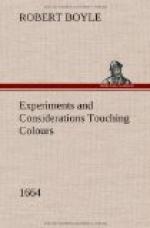to Fusion, and made it Boyl in the glass, impress
any thing of Blackness, or of any other Colour, than
its own pure White, upon this Vegetable concrete.
But what shall we say to Spirit of Wine, which being
made by a Chymical Analysis of the Liquor that affords
it, and being totally Inflamable, seems to have a full
right to the title they give it of Sulphur Vegetabile,
& yet this fluid Sulphur not only contracts not any
degree of Blackness by being often so heated, as to
be made to Boyl, but when it burns away with an Actual
flame, I have not found that it would discolour a
piece of White Paper held over it, with any discernable
soot. Tin also, that wants not, according to the
Chymists, a Sulphur Joviale, when throughly
burned by the fire into a Calx, is not Black,
but eminently White. And I lately noted to you
out of Bellonius, that the Charcoals of Oxy-cedar
are not of the former of these two Colours, but of
the latter. And the Smoak of our Tinby coals here
in England, has been usually observ’d,
rather to Blanch linnen then to Black it. To all
which, other Particulars of the like nature might be
added, but I rather choose to put you in mind of the
third Experiment, about making Black Liquors, or Inks,
of Bodies that were non of them Black before.
For how can it be said, that when those Liquors are
put together actually Cold, and continue so after
their mixture, there intervenes any new Adustion
of Sulphur to produce the emergent Blackness?
(and the same question will be appliable to the Blackness
produc’d upon the blade of a Knife, that has
cut Lemmons and some kind of Sowr apples, if the juyce
(though both Actually and Potentially Cold) be not
quickly wip’d of) And when by the instilling
either of a few drops of Oyl of Vitriol as in the second
Experiment, or of a little of the Liquor mention’d
in the Passage pointed at in the fourth Experiment,
(where I teach at once to Destroy one black Ink, and
make another) the Blackness produc’d by those
Experiments is presently destroy’d; if the Colour
proceeded only from the Plenty of Sulphurous parts,
torrify’d in the Black Bodies, I demand, what
becomes of them, when the Colour so suddenly dissappears?
For it cannot Reasonably be said, that all those that
suffic’d to make so great a quantity of Black
Matter, should resort to so very small a proportion
of the Clarifying Liquor, (if I may so call it) as
to be deluted by it, with out at all Denigrating it.
And if it be said that the Instill’d Liquor
dispers’d those Black Corpuscles, I demand,
how that Dispersion comes to destroy their Blackness,
but by making such a Local Motion of their parts,
as destroys their former Texture? which may be a Matter
of such moment in cases like ours, that I remember
that I have in few houres, without addition, from
Soot it self, attain’d pretty store of Crystalline
Salt, and good store of Transparent Liquor, and (which
I have on another occasion noted as remarkable) this
so Black Substance had its Colour so alter’d,
by the change of Texture it receiv’d from the
fire, wherewith it was distill’d, that it did
for a great while afford such plenty of very white
Exhalations, that the Receiver, though large, seem’d
to be almost fill’d with Milk.




